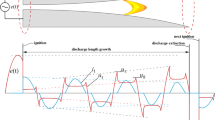Abstract
Several types of plasma discharge have been proven to have a capacity for sterilization. Our goal is to introduce new nonthermal plasma pencil. We used it to sterilize different microbial populations with differing ages. We used a plasma discharge of the following characteristics: radio frequency barrier discharger at atmospheric pressure with a working frequency of 13.56 MHz, and the working gas used was argon. We performed 110 tests with the following microbial populations: Pseudomonas aeruginosa, Staphylococcus aureus, Proteus species, and Klebsiella pneumoniae. All populations were inoculated on the previous day and also on the day of our experiment. We made our evaluations the following day and also after 5 days, with all our microbial populations. Eradication of microbial populations is dependent on the plasma discharge exposure time in all cases. With regard to freshly inoculated microbes, we were able to sterilize agar with intensive exposure lasting for 10 s of colonies Pseudomonas, Proteus, and Klebsiella. The most resistant microbe seems to be S. aureus, which survives 5 s of coherent exposure in half of the cases. Using the lightest plasma discharge exposure, we achieved a maximum of 104–105 CFU/mL (colony-forming unit — CFU). Regarding older microbial populations inoculated the day before the experiment, we can only decrease population growth to 105 CFU/mL approximately, but never completely sterilize. The plasma discharge with our characteristics could be used for the sterilization of the aforementioned superficially growing microbes, but does not sufficiently affect deeper layers and thus seems to be a limitation for eradication of the already erupted colonies.




Similar content being viewed by others
References
Bogle MA, Arndt KA, Dover JS (2007) Plasma skin regeneration technology. J Drugs Dermatol 6(11):1110–1112
Conrads H, Schmidt M (2000) Plasma generation and plasma sources. Plasma Sources Sci Technol 9:441–454
Ehlbeck J, Schnabel U, Polak M, Winter J, von Woedtke T, Brandenburg R, von dem Hagen T, Weltmann K-D (2011) Low temperature atmospheric pressure plasma sources for microbial decontamination. J Phys D Appl Phys 44(1):1–33
Elsaie ML, Kammer JN (2008) Evaluation of plasma skin regeneration technology for cutaneous remodeling. J Cosmet Dermatol 7(4):309–311
Foster KW, Moy RL, Fincher EF (2008) Advances in plasma skin regeneration. J Cosmet Dermatol 7(3):169–179
Fridman G, Peddinghaus M, Ayan H, Fridman A, Balasubramanian M, Gutsol A, Brooks A, Friedman G (2006) Blood coagulation and living tissue sterilization by floating-electrode dielectric barrier discharge in air. Plasma Chem Plasma Process 26:425–442
Justan I, Tichý F, Slavícek P (2010) A new type of plasma knife and its effect on biological issues—a pilot study. Acta Chir Plast 52(2–4):31–34
Kilmer S, Semchyshyn N, Shah G, Fitzpatrick R (2007) A pilot study on the use of a plasma skin regeneration device (Portrait PSR3) in full facial rejuvenation procedures. Lasers Med Sci 22(2):101–109
Kong MG, Kroesen G, Morfill G, Nosenko T, Shimizu T, van Dijk J, Zimmermann JL (2009) Plasma medicine: an introductory review. New J Phys 11:1–35
Laroussi M (1996) Sterilization of contaminated matter with an atmospheric pressure plasma. IEEE Trans Plasma Sci 24(3):1188–1191
Machala Z, Chládeková L, Pelach M (2010) Plasma agents in bio-decontamination by dc discharges in atmospheric air. J Phys D Appl Phys 43(10):1–7
Masaryk University, Brno: The method of making a physically and chemically active environment by means of a plasma jet and the related plasma jet. Inventors: Klima M, Janca J, Kapicka V, Slavicek P, Saul P European Patent Office, Munich, Germany. Patent No.: EP 1077021. 2005-07-27
Scholtz V, Julák J, Kříha V, Mosinger J, Kopecká S (2007) Decontamination effects of low-temperature plasma generated by corona discharge part II: new insights. Prague Med Rep 108(2):128–146
Sladek REJ, Stoffels E (2005) Deactivation of Escherichia coli by the plasma needle. J Phys D Appl Phys 38(11):1716–1721
Traba C, Liang JF (2011) Susceptibility of Staphylococcus aureus biofilms to reactive discharge gases. Biofouling 27(7):763–772
Acknowledgments
This research has been partially supported by grant 202/09/2064 from the Czech Science Foundation and by the research intent MSM: 0021622411 funding from the Ministry of Education of the Czech Republic and by the contract KAN101630651 from Grant Agency of Academy of Science of Czech Republic.
Author information
Authors and Affiliations
Corresponding author
Rights and permissions
About this article
Cite this article
Justan, I., Cernohorska, L., Dvorak, Z. et al. Plasma discharge and time-dependence of its effect to bacteria. Folia Microbiol 59, 315–320 (2014). https://doi.org/10.1007/s12223-014-0301-y
Received:
Accepted:
Published:
Issue Date:
DOI: https://doi.org/10.1007/s12223-014-0301-y




